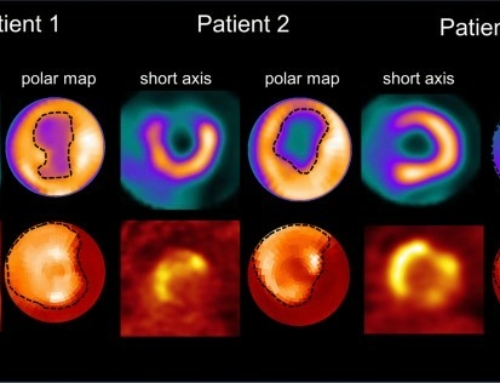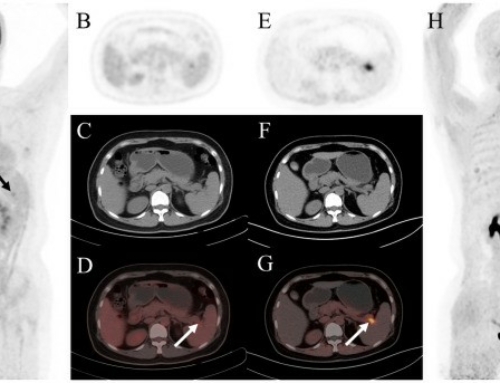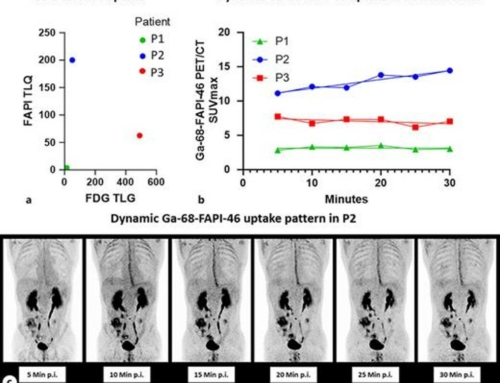Purpose: We evaluated the potential usefulness of [68Ga]Ga-DOTA-FAPI-04 positron emission tomography/computed tomography (PET/CT) for the diagnosis of primary and metastatic lesions in various types of cancer, compared with [18F] FDG PET/CT.
Methods: A total of 75 patients with various types of cancer underwent contemporaneous [68Ga]Ga-DOTA-FAPI-04 and [18F] FDG PET/CT either for an initial assessment or for recurrence detection. Tumour uptake was quantified by the maximum standard uptake value (SUVmax). The sensitivity, specificity, positive predictive value (PPV), negative predictive value (NPV) and accuracy of [18F] FDG and [68Ga]Ga-DOTA-FAPI-04 PET/CT were calculated and compared to evaluate the diagnostic efficacy.
Results: The study cohort consisted of 75 patients (47 males and 28 females; median age, 61.5 years; age range, 32-85 years). Fifty-four patients with 12 different tumour entities underwent paired [68Ga]Ga-DOTA-FAPI-04 and [18F] FDG PET/CT for initial assessment, while the other 21 patients underwent paired scans for recurrence detection. [68Ga]Ga-DOTA-FAPI-04 PET/CT was able to clearly identify 12 types of malignant tumours with favourable tumour-to-background contrast, which resulted in a higher detection rate of primary tumours than did [18F] FDG PET/CT (98.2% vs. 82.1%, P = 0.021). Meanwhile, [68Ga]Ga-DOTA-FAPI-04 PET/CT showed a better sensitivity than [18F] FDG PET/CT in the detection of lymph nodes (86.4% vs. 45.5%, P = 0.004) and bone and visceral metastases (83.8% vs. 59.5%, P = 0.004).
Conclusion: [68Ga]Ga-DOTA-FAPI-04 PET/CT showed a superior diagnostic efficacy than [18F] FDG PET/CT for the diagnosis of primary and metastatic lesions in patients with various types of cancer, especially in identifying liver metastases, peritoneal carcinomatosis, and brain tumours.
Affiliations:
- Department of Nuclear Medicine & Minnan PET Center, Xiamen Cancer Hospital, The First Affiliated Hospital of Xiamen University, Teaching Hospital of Fujian Medical University, Xiamen, China.
- Department of Medical Oncology, Xiamen Cancer Hospital, The First Affiliated Hospital of Xiamen University, Teaching Hospital of Fujian Medical University, Xiamen, China.
- Department of Radiation Oncology, Xiamen Cancer Hospital, The First Affiliated Hospital of Xiamen University, Teaching Hospital of Fujian Medical University, Xiamen, China.
- Fujian Provincial Key Laboratory of Chronic Liver Disease and Hepatocellular Carcinoma, Xiamen, China.
- Department of Nuclear Medicine & Minnan PET Center, Xiamen Cancer Hospital, The First Affiliated Hospital of Xiamen University, Teaching Hospital of Fujian Medical University, Xiamen, China. 13178352662@163.com.
- Department of Radiation Oncology, Xiamen Cancer Hospital, The First Affiliated Hospital of Xiamen University, Teaching Hospital of Fujian Medical University, Xiamen, China. linqin05@163.com.
- Department of Nuclear Medicine & Minnan PET Center, Xiamen Cancer Hospital, The First Affiliated Hospital of Xiamen University, Teaching Hospital of Fujian Medical University, Xiamen, China. wuhua1025@163.com.


![Efficacy of [68Ga]Ga-FAPI-PET as a non-invasive evaluation method of liver fibrosis](https://sofie.com/wp-content/uploads/2025/06/info.ibamolecular-500x383.png)
![Comparison of [99mTc]Tc-FAPI SPECT/CT and [18F]FDG PET/CT as predictive biomarkers for immunotherapy response in gastrointestinal cancer](https://sofie.com/wp-content/uploads/2025/06/info.ibamolecular-500x383.jpg)


